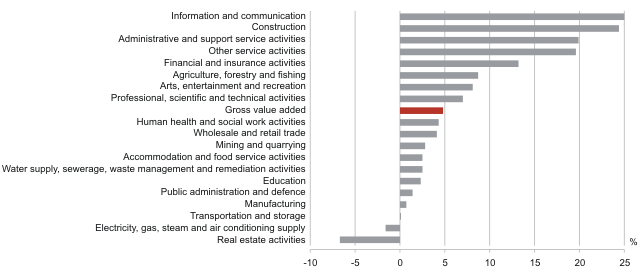Last year the economy thrived in Estonia
According to Statistics Estonia, in 2011 the gross domestic product (GDP) increased by 7.6% compared to the previous year. In the 4th quarter, GDP growth decelerated to 4.5% according to the second estimates.
2011
In 2011 the GDP at current prices was 15.97 billion euros.
In the first three quarters of 2011, GDP growth was mainly driven by manufacturing. Construction and information and communication activities started to contribute the most to economic growth since the second half-year. The increase in the value-added tax and excise duty collected also had a significant impact. The value added of manufacturing grew mainly with the support of exports, with the manufacturing of computers, electronic and optical products having the biggest influence on this growth. The growth in construction was mainly supported by the repair and reconstruction work of buildings. The fast growth of information technology and telecommunication services had the biggest impact on the growth of the value added of information and communication.
GDP growth was inhibited by the decrease in the value added of real estate activities. The value added of this economic activity has decreased already for one and a half years, that is, since the 3rd quarter of 2010. The decrease in the value added of imputed rent calculations of dwellings at both current and constant prices, including fast-growing rentals, has been the main reason for this decrease.
Domestic demand increased by 11% in 2011, mainly due to the fast growth of gross capital formation, especially due to business-sector investments in transport equipment and machinery and equipment. Inventories of goods and materials of the business sector increased fast. Household final consumption expenditures increased moderately, influenced mainly by the increase in purchase of vehicles and catering services. Despite the fast growth of domestic demand, the total of final consumption expenditures and capital formation was still less than the GDP by output method. Domestic demand decreased below the GDP in 2009, before that it had been bigger than the GDP by output method.
In 2011, the export of goods and services grew by 25% in real terms, whereas the export of goods increased by 32%. The import of goods and services increased by 27%, with the import of goods improving by 28%. The fast growth of exports and imports of computers, electronic and optical products had the biggest influence on Estonian foreign trade. The export of goods was also significantly supported by the exports of other machinery and equipment, whereas import by the imports of wood and wood products. Import of services grew fast, mainly due to goods transportation services by air transport. The share of net exports in the GDP was 4.9%. The figure has been positive already for three years, although compared to 2010 the level decreased.
4th quarter 2011
The GDP at current prices was 4.22 billion euros in the 4th quarter. Compared to the 3rd quarter, the seasonally and working-day adjusted GDP decreased by 0.2% in the 4th quarter. Compared to the same quarter of the previous year, GDP growth decelerated to 4.5%.
The growth of value added of manufacturing, which has had the biggest impact on economic growth during the past year and a half, decelerated and its contribution to GDP growth decreased sharply. The value added of manufacturing grew mainly with the support of exports. The export growth of goods of manufacturing decelerated sharply in the 4th quarter 2011, mainly due to the decrease in the export of computers, electronic and optical products.
GDP growth was boosted the most by the fast growth of the value added of construction and information and communication. The growth in construction was supported mainly by the repair and reconstruction work of buildings. The construction volume of civil engineering works also increased rapidly. The fast growth of information technology and telecommunication services had the biggest impact on the growth of the value added of information and communication.
In the 4th quarter, GDP growth was inhibited by the decrease in the value added of energy supply and real estate activities. The decrease in electricity production, partly caused by the replacement of own production with import and by the decrease in energy consumption due to milder weather, had an impact on energy supply. The decrease in the value added of imputed rent calculations of dwellings at both current and constant prices, including fast-growing rentals, has been the main reason for the decrease in the value added of real estate activities.
Growth of the value added of economic activities, 4th quarter 2011
Domestic demand increased by 8% in the 4th quarter, boosted mainly by the fast growth of gross fixed capital formation. Gross fixed capital formation grew by 34%, primarily due to business-sector investments in machinery and equipment and in buildings and structures. Household final consumption expenditures increased by 5%. Increase in the purchase of vehicles, consumption of catering and telephone services and purchase of alcoholic beverages contributed the most to the growth of household final consumption expenditures. The growth of domestic demand was inhibited by the decrease in inventories of goods and materials of the business sector.
In the 4th quarter, the export growth of goods and services decelerated to 10%, with the export growth of goods also decelerating to 10%. Such deceleration of export considerably inhibited GDP growth. Import of goods and services increased by 13%, with import of goods growing by 12% and import of services by 19%. Before the 4th quarter 2011, Estonian foreign trade was mainly influenced by the fast growth of the import and export of computers, electronic and optical products, while in the 4th quarter the growth of these goods was replaced by a decrease and other machinery and equipment had the biggest contribution. The import of services was influenced the most by the fast growth of goods transportation services by sea transport. The share of net exports in the GDP increased to 4.5%.
